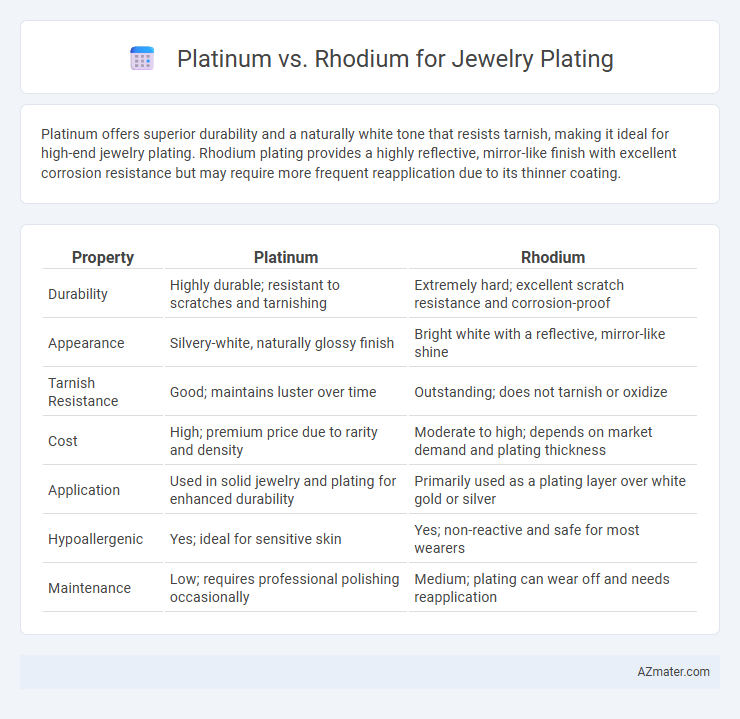Platinum offers superior durability and a naturally white tone that resists tarnish, making it ideal for high-end jewelry plating. Rhodium plating provides a highly reflective, mirror-like finish with excellent corrosion resistance but may require more frequent reapplication due to its thinner coating.
Table of Comparison
| Property | Platinum | Rhodium |
|---|---|---|
| Durability | Highly durable; resistant to scratches and tarnishing | Extremely hard; excellent scratch resistance and corrosion-proof |
| Appearance | Silvery-white, naturally glossy finish | Bright white with a reflective, mirror-like shine |
| Tarnish Resistance | Good; maintains luster over time | Outstanding; does not tarnish or oxidize |
| Cost | High; premium price due to rarity and density | Moderate to high; depends on market demand and plating thickness |
| Application | Used in solid jewelry and plating for enhanced durability | Primarily used as a plating layer over white gold or silver |
| Hypoallergenic | Yes; ideal for sensitive skin | Yes; non-reactive and safe for most wearers |
| Maintenance | Low; requires professional polishing occasionally | Medium; plating can wear off and needs reapplication |
Introduction to Platinum and Rhodium Plating
Platinum and rhodium plating are popular techniques used to enhance jewelry durability and appearance, with platinum offering a naturally white, hypoallergenic surface that resists tarnish and scratches, while rhodium plating provides a highly reflective, bright white finish commonly applied over white gold and silver to improve luster and prevent oxidation. Both metals belong to the platinum group metals (PGMs) and are valued for their corrosion resistance and rarity. Rhodium plating typically requires periodic reapplication due to its thin layer, whereas platinum plating tends to be thicker and longer-lasting, making the choice dependent on the desired aesthetic and maintenance preferences.
Chemical Properties: Platinum vs Rhodium
Platinum exhibits exceptional chemical stability and resistance to oxidation, making it highly durable for jewelry plating. Rhodium, a member of the platinum group metals, offers superior hardness and reflects light with a brilliant, mirror-like finish but tends to wear faster due to its thinner plating layer. Both metals resist tarnishing, but rhodium's higher reflectivity and strong corrosion resistance make it ideal for enhancing the brightness of white gold and silver jewelry.
Durability and Wear Resistance
Platinum and rhodium both offer exceptional durability and wear resistance for jewelry plating, with rhodium providing a harder, more scratch-resistant surface ideal for everyday wear. Platinum plating, while slightly softer, offers superior corrosion resistance and maintains its lustrous appearance longer under normal conditions. Rhodium's bright white finish enhances the jewelry's brilliance but may require more frequent re-plating compared to the more enduring platinum layer.
Aesthetic Appeal and Color Differences
Platinum offers a soft white sheen with a subtle grayish tint, providing a classic and elegant look to jewelry that gently enhances the design's intricate details. Rhodium plating imparts a brighter, more reflective white finish with a cooler, almost mirror-like appearance that significantly intensifies the jewelry's brilliance and modern appeal. Choosing between platinum and rhodium plating depends on desired color intensity and style preference, with platinum favoring understated sophistication while rhodium delivers a bold, luminous shine.
Allergic Reactions and Skin Sensitivity
Platinum jewelry plating is highly hypoallergenic and ideal for individuals with sensitive skin, as it rarely causes allergic reactions due to its inert properties. Rhodium plating, although also hypoallergenic and commonly used to enhance the shine and durability of white gold and silver, can cause mild skin sensitivity in rare cases due to trace metal impurities. Choosing platinum plating often ensures better compatibility for those with metal allergies or sensitive skin conditions.
Cost Comparison of Platinum and Rhodium Plating
Platinum plating typically costs significantly more than rhodium plating due to its higher raw material price and more complex application process. Rhodium plating is favored for its affordability, often costing a fraction of platinum, making it a popular choice for enhancing jewelry durability and shine without a premium price. The choice between platinum and rhodium plating hinges on budget considerations, with rhodium offering a cost-effective option while platinum delivers a more luxurious and long-lasting finish.
Maintenance and Longevity
Platinum jewelry plating offers exceptional durability and resists tarnishing, requiring minimal maintenance to retain its lustrous appearance over time. Rhodium plating, while providing a highly reflective and bright finish, tends to wear off faster and may need reapplication every 6 to 12 months depending on wear and skin chemistry. Regular cleaning with mild soap and avoiding abrasive materials can significantly prolong the lifespan of both platinum and rhodium plated jewelry.
Popular Jewelry Applications
Platinum and rhodium plating are popular choices in fine jewelry, each offering distinct benefits for different applications. Platinum is favored for engagement rings and high-end pieces due to its natural white sheen and hypoallergenic properties, enhancing durability without frequent re-plating. Rhodium is widely used for white gold and sterling silver jewelry to provide a bright, reflective finish and prevent tarnishing, especially in wedding bands and fashion accessories.
Environmental and Ethical Considerations
Platinum and rhodium are both precious metals used in jewelry plating, but rhodium plating often involves environmental concerns due to toxic waste and hazardous chemicals used in the electroplating process. Platinum mining, while still impactful, generally follows more rigorous ethical standards and sustainability initiatives compared to rhodium extraction, which is less regulated and can contribute to environmental degradation. Choosing platinum for jewelry plating supports eco-friendly practices and responsible sourcing, reducing the carbon footprint and promoting fair labor conditions within the precious metals industry.
Choosing the Best Metal for Jewelry Plating
Platinum offers exceptional durability and a naturally white sheen that resists tarnishing, making it ideal for high-end jewelry plating. Rhodium plating provides a highly reflective, mirror-like finish and excellent scratch resistance, often enhancing white gold pieces. Selecting the best metal depends on desired aesthetics and wear resistance, with rhodium favored for bright, reflective coatings and platinum preferred for long-lasting, hypoallergenic protection.

Infographic: Platinum vs Rhodium for Jewelry Plating
 azmater.com
azmater.com